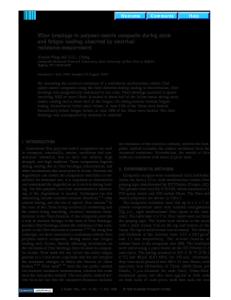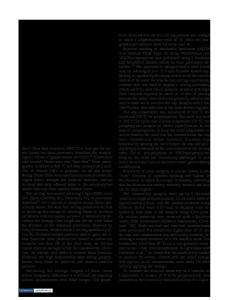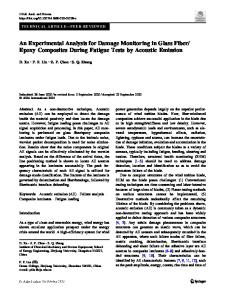Early Fatigue Damage In Carbon Fiber Composites Observed By Electrical Resistance Measurement
- PDF / 442,853 Bytes
- 6 Pages / 414.72 x 648 pts Page_size
- 4 Downloads / 341 Views
Downloaded from https://www.cambridge.org/core. Lund University Libraries, on 18 Jan 2020 at 03:14:10, subject to the Cambridge Core terms of use, available at https://www.cambridge.org/core/terms. https://doi.org/10.1557/PROC-503-75
monitoring. These sensors can be optical fibers and a variety of strain gages. They suffer from poor durability and, in the case of embedded sensors, they have the tendency to degrade the mechanical properties of the structure. In contrast, we have employed a carbon-fiber composite itself as the strain sensor to monitor the composite's own strain, based on the reversible increase of the electrical resistance upon straining. In addition, the composite monitors its own damage. This paper describes electrical resistance measurement for monitoring fatigue damage in carbon fiber composites, i.e., continuous carbon fiber carbon-matrix composite (or carbon-carbon composite) [1], short carbon fiber polymer-matrix composite [2] and short carbon fiber cement-matrix composite [3]. Carbon is suitable because it is conducting and carbon fiber composites are technologically important. CARBON-CARBON COMPOSITE Carbon-carbon composites with continuous carbon fibers are used for hightemperature aerospace structures, due to the high-temperature resistance of the carbon matrix. The carbon matrix, though much more high-temperature resistant than a polymer matrix, is brittle, so structural health monitoring is needed. The carbon-carbon composite, kindly provided by Sigri Great lakes Carbon Corp. (Union, NJ) under the grade designation of CC 1501G, was in the form of a sheet containing carbon fiber roving fabric (90' biaxial weaving) and was produced by lamination and compression. The heat treatment temperature used in production was 2000'C. The bulk density was 1.40 - 1.45 g/cm 3. The tensile strength was - 382 MPa. The electrical resistance R was measured in the direction of one of the two perpendicular sets of fibers using the four-probe method while cyclic and static tension until failure was applied in the same direction. Silver electrically conducting paint was used for electrical contacts. The resistance R refers to the sample DC resistance between the inner probes. The four electrical contacts were placed around the perimeter of the sample in parallel planes perpendicular to the stress axis. The stress axis was along the longest dimension of the specimen. Strain gages were used to measure the strain in the longitudinal, transverse and thickness directions. Figure 1 shows the stress (curve (a)) and the fractional resistance increase (AR/Ro) (curve (b)) during static tension up to failure. ARJRo increased with strain, such that the increase was gradual (slightly above the increase in AR/Ro due to changes in dimensions, curve (c)) at low strains and abrupt at high strains. Fig. 2 shows AR/Ro during cyclic tension to a stress amplitude (360 MPa) equal to 94% of the breaking stress. The strain was almost totally reversible. The irreversible strain was 0.040% at the end of the first cycle, and increased s
Data Loading...











